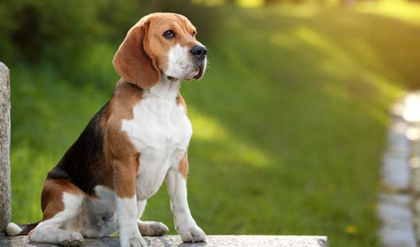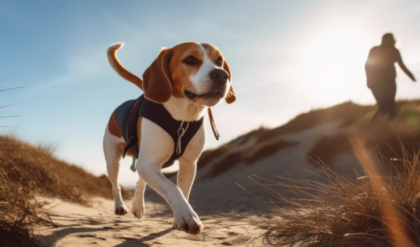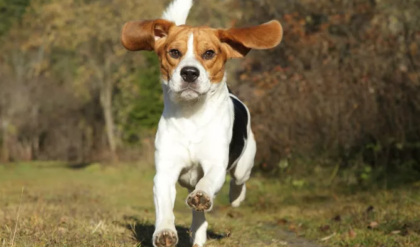Beagles are known for their curious and energetic nature, making off-leash training both a challenge and a rewarding experience. Teaching your Beagle to walk off-leash can provide them with the freedom to explore their surroundings while still remaining obedient and safe. This comprehensive guide will take you through the steps, tips, and important considerations when training your Beagle to walk off-leash.

Establishing the Foundation (On-Leash Leash Training)
Introduction
When it comes to off-leash training, the journey begins with establishing a solid foundation through on-leash training. This phase is crucial for teaching your Beagle proper leash manners and obedience, setting the stage for successful off-leash walks in the future.
Steps to Follow:
- Start with Basic Commands: Begin by teaching your Beagle basic commands such as “sit,” “stay,” and “come.” These commands will form the building blocks of their obedience training.
- Practice Loose Leash Walking: Encourage your Beagle to walk beside you without pulling on the leash. Use treats and positive reinforcement to reward good behavior.
- Consistent Training: Dedicate time each day to practice on-leash walking and obedience training. Consistency is key to reinforcing good habits in your Beagle.
Table 1: On-Leash Leash Training Schedule
| Week | Activities |
|---|---|
| 1 | Basic commands: Sit, Stay, Come |
| 2-4 | Loose leash walking practice |
| 5-8 | Obedience training with distractions |
By following these steps and staying consistent with your training, you’ll be laying the groundwork for successful off-leash training with your Beagle.
Transitioning to Long Leash Training
Introduction
Once your Beagle has mastered on-leash walking and basic obedience, it’s time to transition to long leash training. Using a long leash allows your dog to explore their surroundings with more freedom while still maintaining control and safety.
Steps to Follow:
- Introduce the Long Leash: Attach a long training leash (about 20-30 feet) to your Beagle’s collar. Allow them to drag the leash behind them while exploring a safe, enclosed area.
- Practice Recall Commands: Practice calling your Beagle back to you using recall commands like “come” or a whistle. Reward them for returning to you promptly.
- Gradually Increase Distance: Slowly increase the distance between you and your Beagle while they are on the long leash. This helps them get used to being farther away from you while still responding to commands.
List 1: Long Leash Training Tips
- Use a lightweight long leash to prevent it from getting tangled or caught on objects.
- Practice in an enclosed area to ensure your Beagle’s safety and prevent them from running off.
- Reward your Beagle with treats and praise for responding to recall commands and coming back to you.
By following these steps and tips, your Beagle will become more confident and skilled at being off-leash in a controlled environment.
Gradual Introduction to Off-Leash Practice
Introduction
After your Beagle has mastered on-leash and long leash training, it’s time to gradually introduce off-leash moments in a safe and controlled environment. This phase requires patience and careful supervision to ensure your Beagle’s safety while allowing them the freedom to explore.
Steps to Follow:
- Start in a Secure Area: Begin off-leash practice in a securely fenced area away from distractions or potential hazards. This will minimize the risk of your Beagle wandering off.
- Monitor Behavior Closely: Keep a close eye on your Beagle’s behavior and body language during off-leash practice. Look for signs of distraction, fear, or excitement that may impact their obedience.
- Reward Good Behavior: Continuously reinforce good behavior with treats and praise. Celebrate small victories such as coming when called or staying by your side off-leash.
Table 2: Off-Leash Training Progress Tracker
| Session | Behaviors Observed | Notes |
|---|---|---|
| 1 | Responsive to recall commands | Comfortable within fenced area |
| 2 | Exploring surroundings confidently | Checked in periodically |
| 3 | Maintained focus and stayed near owner | Responded well to distractions |
By gradually introducing off-leash practice and maintaining a positive training environment, you’ll build trust and confidence with your Beagle while enjoying the freedom of off-leash walks together.
Important Tips for Successful Off-Leash Training
Introduction
In addition to the specific training steps outlined above, there are some important tips to keep in mind throughout the off-leash training process. These tips will help you navigate potential challenges and set your Beagle up for success in their off-leash adventures.
Tips to Follow:
- Patience is Key: Off-leash training takes time and patience. Avoid rushing the process and celebrate small wins along the way.
- Focus on Obedience: Emphasize obedience training throughout the off-leash journey. A well-behaved Beagle is more likely to succeed off-leash.
- Use the Heel Command: Teach your Beagle the “heel” command to keep them walking calmly by your side. This command helps maintain control and reinforces good leash manners.
List 2: Additional Tips for Off-Leash Training
- Avoid punishing your Beagle for mistakes during training as this can hinder their progress and erode trust.
- Practice off-leash walks in different environments to expose your Beagle to varying distractions and scenarios.
- Always supervise your Beagle when off-leash and be prepared to intervene if necessary for their safety.
By incorporating these important tips into your off-leash training routine, you’ll create a positive and effective learning experience for your Beagle.
Conclusion
In conclusion, off-leash training for your Beagle is a rewarding journey that requires time, effort, and dedication. By following the comprehensive guide outlined above, you can set clear training goals, establish a solid foundation, and gradually introduce off-leash opportunities for your furry companion. Remember to stay patient, consistent, and positive throughout the training process, and always prioritize your Beagle’s safety and well-being. With the right approach and mindset, you’ll soon enjoy the benefits of off-leash walks with your well-trained Beagle.






